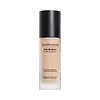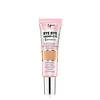bareMinerals Original Pure Serum Radiant Natural Liquid Foundation Mineral SPF 20 Versus IT Cosmetics Bye Bye Undereye Illumination Full Coverage Anti-Aging Waterproof Concealer
What's inside
What's inside
 Key Ingredients
Key Ingredients

 Benefits
Benefits

 Concerns
Concerns

 Ingredients Side-by-side
Ingredients Side-by-side

Caprylic/Capric Triglyceride
MaskingCoconut Alkanes
EmollientMica
Cosmetic ColorantSilica
AbrasiveStearalkonium Hectorite
Gel FormingCoco-Caprylate/Caprate
EmollientGlycerin
HumectantLecithin
EmollientJojoba Esters
EmollientPropylene Carbonate
SolventPhenoxyethanol
PreservativeTocopheryl Acetate
AntioxidantButylene Glycol
HumectantWater
Skin ConditioningMagnesium Ascorbyl Phosphate
AntioxidantNymphaea Alba Flower Extract
Skin ConditioningSodium Hyaluronate
HumectantCI 77891
Cosmetic ColorantIron Oxides
Caprylic/Capric Triglyceride, Coconut Alkanes, Mica, Silica, Stearalkonium Hectorite, Coco-Caprylate/Caprate, Glycerin, Lecithin, Jojoba Esters, Propylene Carbonate, Phenoxyethanol, Tocopheryl Acetate, Butylene Glycol, Water, Magnesium Ascorbyl Phosphate, Nymphaea Alba Flower Extract, Sodium Hyaluronate, CI 77891, Iron Oxides
Caprylic/Capric Triglyceride
MaskingBis-Diglyceryl Polyacyladipate-2
EmollientVp/Hexadecene Copolymer
Cetyl Alcohol
EmollientSilica Dimethyl Silylate
EmollientMicrocrystalline Wax
Emulsion StabilisingPhenoxyethanol
PreservativeNiacinamide
SmoothingSodium Hyaluronate
HumectantMagnesium Ascorbyl Phosphate
AntioxidantTocopheryl Acetate
AntioxidantAscorbyl Palmitate
AntioxidantHydrolyzed Collagen
EmollientWater
Skin ConditioningPentaerythrityl Tetra-Di-T-Butyl Hydroxyhydrocinnamate
AntioxidantCholesteryl Isostearate
EmollientCholesteryl Chloride
Skin ConditioningCholesteryl Nonanoate
EmollientGlycerin
HumectantSteareth-20
CleansingSilica
AbrasiveChlorhexidine Digluconate
AntimicrobialN-Hydroxysuccinimide
Skin ConditioningBHT
AntioxidantSodium Citrate
BufferingPotassium Sorbate
PreservativePalmitoyl Tripeptide-1
Skin ConditioningChrysin
Skin ConditioningPalmitoyl Tetrapeptide-7
Skin ConditioningCitric Acid
BufferingBiotin
AntiseborrhoeicTitanium Dioxide
Cosmetic ColorantIron Oxides
Mica
Cosmetic ColorantCaprylic/Capric Triglyceride, Bis-Diglyceryl Polyacyladipate-2, Vp/Hexadecene Copolymer, Cetyl Alcohol, Silica Dimethyl Silylate, Microcrystalline Wax, Phenoxyethanol, Niacinamide, Sodium Hyaluronate, Magnesium Ascorbyl Phosphate, Tocopheryl Acetate, Ascorbyl Palmitate, Hydrolyzed Collagen, Water, Pentaerythrityl Tetra-Di-T-Butyl Hydroxyhydrocinnamate, Cholesteryl Isostearate, Cholesteryl Chloride, Cholesteryl Nonanoate, Glycerin, Steareth-20, Silica, Chlorhexidine Digluconate, N-Hydroxysuccinimide, BHT, Sodium Citrate, Potassium Sorbate, Palmitoyl Tripeptide-1, Chrysin, Palmitoyl Tetrapeptide-7, Citric Acid, Biotin, Titanium Dioxide, Iron Oxides, Mica
Ingredients Explained
These ingredients are found in both products.
Ingredients higher up in an ingredient list are typically present in a larger amount.
This ingredient is an emollient, solvent, and texture enhancer. It is considered a skin-softener by helping the skin prevent moisture loss.
It helps thicken a product's formula and makes it easier to spread by dissolving clumping compounds.
Caprylic Triglyceride is made by combining glycerin with coconut oil, forming a clear liquid.
While there is an assumption Caprylic Triglyceride can clog pores due to it being derived from coconut oil, there is no research supporting this.
Learn more about Caprylic/Capric TriglycerideGlycerin is already naturally found in your skin. It helps moisturize and protect your skin.
A study from 2016 found glycerin to be more effective as a humectant than AHAs and hyaluronic acid.
As a humectant, it helps the skin stay hydrated by pulling moisture to your skin. The low molecular weight of glycerin allows it to pull moisture into the deeper layers of your skin.
Hydrated skin improves your skin barrier; Your skin barrier helps protect against irritants and bacteria.
Glycerin has also been found to have antimicrobial and antiviral properties. Due to these properties, glycerin is often used in wound and burn treatments.
In cosmetics, glycerin is usually derived from plants such as soybean or palm. However, it can also be sourced from animals, such as tallow or animal fat.
This ingredient is organic, colorless, odorless, and non-toxic.
Glycerin is the name for this ingredient in American English. British English uses Glycerol/Glycerine.
Learn more about GlycerinMagnesium Ascorbyl Phosphate (MAP) is a form of Vitamin C and is an antioxidant. It can help to reduce redness, improve skin texture, reduce the effects of aging, reduce the visibility of dark spots, and brighten skin.
MAP is created by combining ascorbic acid with magnesium salt. While MAP more gentle on the skin than ascorbic acid, it is thought to be less easily-absorbed into the skin.
Due to MAP's stability up to a pH level of 7, it is more stable to air and sunlight exposure than ascorbic acid. The best pH range for MAP is between 5 and 6.
Like other forms of Vitamin C, MAP has been shown to help reduce hyperpigmentation and simulate collagen production.
As an antioxidant, it helps protect your skin against the signs of aging.
Learn more about Magnesium Ascorbyl PhosphateMica is a naturally occurring mineral used to add shimmer and color in cosmetics. It can also help improve the texture of a product or give it an opaque, white/silver color.
Serecite is the name for very fine but ragged grains of mica.
This ingredient is often coated with metal oxides like titanium dioxide. Trace amounts of heavy metals may be found in mica, but these metals are not harmful in our personal products.
Mica has been used since prehistoric times throughout the world. Ancient Egyptian, Indian, Greek, Roman, Aztec, and Chinese civilizations have used mica.
Learn more about MicaPhenoxyethanol is a preservative that has germicide, antimicrobial, and aromatic properties. Studies show that phenoxyethanol can prevent microbial growth. By itself, it has a scent that is similar to that of a rose.
It's often used in formulations along with Caprylyl Glycol to preserve the shelf life of products.
Silica, also known as silicon dioxide, is a naturally occurring mineral. It is used as a fine, spherical, and porous powder in cosmetics.
Though it has exfoliant properties, the function of silica varies depending on the product.
The unique structure of silica enhances the spreadability and adds smoothness, making it a great texture enhancer.
It is also used as an active carrier, emulsifier, and mattifier due to its ability to absorb excess oil.
In some products, tiny microneedles called spicules are made from silica or hydrolyzed sponge. When you rub them in, they lightly polish away dead skin layers and enhance the penetration of active ingredients.
Learn more about SilicaSodium Hyaluronate is hyaluronic acid's salt form. It is commonly derived from the sodium salt of hyaluronic acid.
Like hyaluronic acid, it is great at holding water and acts as a humectant. This makes it a great skin hydrating ingredient.
Sodium Hyaluronate is naturally occurring in our bodies and is mostly found in eye fluid and joints.
These are some other common types of Hyaluronic Acid:
Learn more about Sodium HyaluronateTocopheryl Acetate is AKA Vitamin E. It is an antioxidant and protects your skin from free radicals. Free radicals damage the skin by breaking down collagen.
One study found using Tocopheryl Acetate with Vitamin C decreased the number of sunburned cells.
Tocopheryl Acetate is commonly found in both skincare and dietary supplements.
Learn more about Tocopheryl AcetateWater. It's the most common cosmetic ingredient of all. You'll usually see it at the top of ingredient lists, meaning that it makes up the largest part of the product.
So why is it so popular? Water most often acts as a solvent - this means that it helps dissolve other ingredients into the formulation.
You'll also recognize water as that liquid we all need to stay alive. If you see this, drink a glass of water. Stay hydrated!
Learn more about WaterThis ingredient is a combination of red, black, and yellow iron oxide pigments. This combination of colors is usually found in foundation, because it results in a "skin" color.